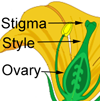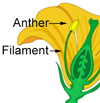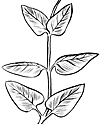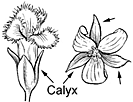'Ohi'a Lehua
Metrosideros polymorpha
Eucalyptus-Like family (Myrtaceae)
Native species ()
‘Ōhi‘a lehua, the most common and most widespread large tree of Hawaii’s wet forests, is well known by its showy clusters of large red flowers formed by a mass of threadlike and by its crowded paired small leaves. Extremely variable and divided into numerous varieties based on leaf shape, hairiness, and flower color, varying from scarlet to pink, salmon, and yellow. The red-flower form is the official county flower of the Island of Hawaii.
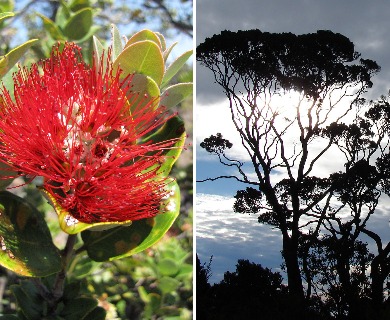
©2012 Forest And Kim Starr
Leaves crowded, short-stalked to nearly stalkless, from hairless to white hairy, the young leaves often reddish. Blades small, very variable, elliptical, or rounded, mostly 3⁄4–3 inches (2–7.5 ) long and 1⁄2–1 1⁄2 inches (1.3–4 ) wide, short-pointed to rounded at both ends, sometimes notched at base, not on edges, slightly thick and leathery, upper surface commonly shiny green or dull and hairless, with many fine side veins usually inconspicuous or not visible, and lower surface paler and often hairy, sometimes with dense coat of white hairs.
Flower clusters (cymose ) branched, of many short-stalked flowers in groups of three forming mass of threadlike to 3 inches (7.5 ) in diameter, varying in color from scarlet to pink, salmon, and yellow. Each flower is composed of a bell-shaped base () to 1⁄4 inch (6 ) long, which bears five blunt 1⁄8 inch (3 ) long, four petals 1⁄8–1⁄4 inch (3–6 ) long, and many spreading threadlike 1–1 1⁄4 inches (2.5–3 ) long with dot with inferior three-celled and long threadlike
() bell-shaped, 1⁄4–3⁄8 inch (6–10 ) long and broad, brown, often hairy, slightly three- three-celled, with remaining. Seeds are many and minute.
Sapwood is pale brown, grading gradually into reddish-brown heartwood. The wood is heavy ( gr. 70), very hard, strong, and has a large shrinkage in drying. It is not resistant to decay but is moderately resistant to subterranean termites. Although variable in this characteristic, most ‘ohi’a wood is readily pressure treated with preservatives.
The Hawaiians used the wood for construction, carved images, household implements, and wear-strips along the gunwales of canoes.
Principal modern uses include flooring, ship blocking, marine construction, irrigation canal stakes, pallets, fence posts, and decorative poles. Objects made from the wood have ranged from ukulele keys to railroad crossties. The Santa Fe Railroad Company used about 5 million ‘ōhi‘a ties on the West Coast in the early part of the century until the wood was found not durable. Drawbacks to wider use of ‘ōhi‘a are its density and shrinkage, which limit its usefulness, coupled with expensive logging because it occurs only in low-volume stands.
The flowers are used in weaving beautiful garlands or leis and are considered sacred to Pele, goddess of volcanoes, and thus the subject of songs and legends. Native birds feed upon the secreted The small bird called ‘i‘iwi has scarlet plumage, which matches the flowers. Another, ‘apapane, is dark red like the darker red-flowered lehua ‘apane. However, green birds such as ‘amakihi also feed on the flowers.
Young red leaves called liko lehua are used in leis and folk remedies and make a pleasant tea. Because of the abundant this species is classed as a honey plant.
The seeds commonly germinate on trunks of treeferns in the forest understory. Then the seedlings send roots down to the ground. These roots may enclose the fern trunk. Thus, the larger tree is often supported on its roots, having shaded and killed its host. Because of this habit, early Hawaiians regarded the fern as the parent. Mature trees sometimes produce large masses of roots that hang down from branches and may take up some moisture from the air. ‘Ōhi‘a lehua seedlings also get an early start on fresh aa lava flows. The pioneer fern Sadleria serves as a nurse plant for the germination and establishment of an ‘ōhi‘a lehua tree. But most ‘ōhi‘a lehua trees originate from seed that has germinated in the soil. Seedlings are commonly found along the edges of roads. As with koa and other trees, soil disturbance forms a good seed bed. Intolerant of shade as a seedling, this species requires an opening to get started.
This species is distributed from sea level to timber line at 8,500 ft (2,591 ) through wet to dry forests. It is the dominant or most common native tree through the islands. It may occur as a shrubby tree on exposed lava flows or even as a low creeping or shrub exposed on mountain ridges and in bogs.
Special areas
Kokee, Keahua, Waimea Arboretum, Aiea, Haleakala, Kalopa, Volcanoes, Kipuka Puaulu
Champion
Height 84 ft (25.6 ), c.b.h. 17.8 ft (5.4 ), spread 78 ft (23.8 ). Waipunalei, Hilo, Hawaii (1968).
Range
Six largest Hawaiian islands
Other common name
lehua ‘ōhi‘a
Botanical
Metrosideros collina (J. R. & G. Forst.) Gray polymorpha (Gaud.) Rock
The common name lehua meaning hair, may have been suggested by the numerous threadlike Many other names were applied to variations in flowers and leaves, according to Rock. Lehua mamo had orange yellow flowers; lehua pua kea, white flowers; lehua kū makua, stalkless heart-shaped leaves; lehua lau li‘i, very small leaves.
The Hawaiian trees have been classed also as a of Metrosideros collina (J. R. & G. Forst.) Gray, which occurs on high South Pacific islands to New Zealand (Rock 1917b). However, that species, as defined in the monograph by Dawson (1970) and supported by St. John (1979), is restricted to Tahiti and Rarotonga. The shorter name with rank of species, Metrosideros polymorpha Gaud., is simpler and appropriate for the numerous Hawaiian variations distinguished further as about eight varieties. Also, four other local species within Hawaii have been accepted.

